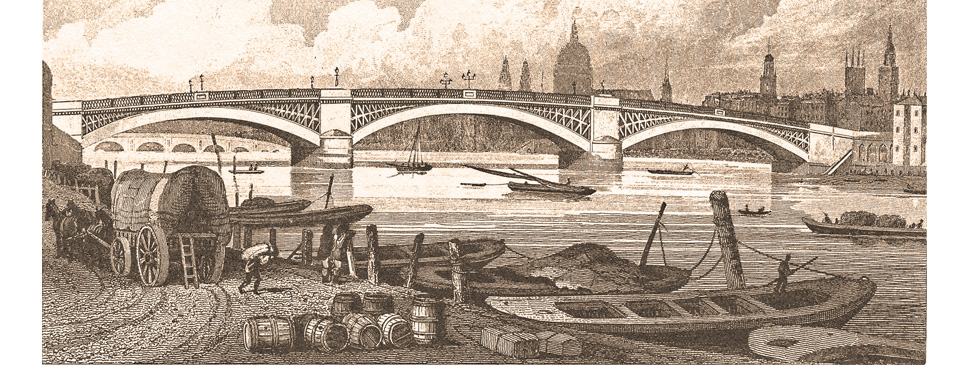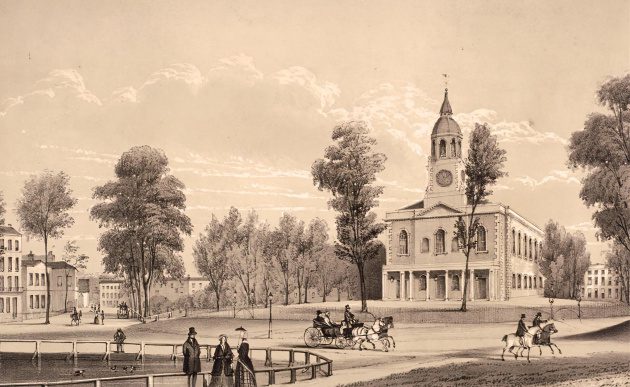The original Southwark Bridge

John Rennie’s elegant Southwark Bridge was the most ambitious cast-iron bridge of the period and the peak of achievement in that field. The railway and civil engineer Robert Stephenson considered it unrivalled in its colossal proportions, architectural effect, general simplicity, and massive character of its details. This view by T.H. Shepherd was published in 1829.
Southwark Bridge was the third of three toll-crossings over the Thames opened in quick succession between 1816 and 1819. The engineer John Rennie was associated with all three. All were good examples of engineering art and science, but none proved to be a commercial success. Nevertheless, Southwark Bridge was a remarkable achievement for its time, with the largest cast-iron span attempted thus far.
During the second decade of the 19th century Britain was fighting the Peninsula War in Spain and, no doubt, the government had greater priorities than bridges across the Thames. Yet many were profiting from the war and needed somewhere to invest their funds. The volume of long-distance road travel increased as roads improved. Several groups of speculators felt the time was right for private toll-bridges across the river in the London and Westminster area, resulting in Vauxhall, Waterloo and Southwark bridges in quick succession.
London Bridge and Blackfriars Bridge, both owned by the City of London and managed by their Bridge House Estates, had become congested. The Southwark Bridge Company was formed by a private Act of Parliament in May 1811, two years after Vauxhall and Waterloo bridges, to create a new crossing on the narrowest part of the river, linking the City with Southwark. It was estimated that traffic would be about a third of Blackfriars Bridge, providing a tidy profit.
There were objections from the City of London Corporation and Thames Conservators that it would hinder river traffic due to the narrow width of the river at that point. The company was therefore forced to make an undertaking to construct the bridge with only three arches, which had never been attempted before on the Thames. John Rennie was commissioned to provide the design. Thomas Telford had created a one-span iron bridge over the narrow River Severn a decade earlier and iron was Rennie’s solution.
At that time Rennie was also involved in a nearby bridge just downriver that would be named Waterloo Bridge, and had previously provided initial, but unused, designs for Vauxhall Bridge.
The approach from the City side was to be made from a junction with Cannon Street, through part of the ancient Three Cranes Wharf. Due to the requirement for just three spans Rennie made the bridge from criss-crossed iron arches. The piers of Bramley Fall and Whitely stone from quarries near Edinburgh and Dundee were bonded both vertically and horizontally ensuring maximum stability, and topped by a balustrade. A bridge over the River Wear at Sunderland, completed in 1796, was considered an engineering triumph with a central span of 236 feet but Rennie’s central span, at 240 feet, became the widest ever attempted. The three arches were relatively flat but the voussoirs – the wedge shapes that keep the arch in place – were made of solid cast-iron, bolted together, to minimize thrust. The two side arches were each of two 210 feet. The ironwork, weighing between five and six thousand tons in total with individual pieces of up to ten tons, was cast by Walkers of Rotherham. Granite was brought from Peterhead in Aberdeenshire and transported as large blocks around the coast on cargo streamers.
Work began in 1814. The foundation stone was laid by Admiral Lord Keith, a distinguished naval commander, at a ceremony in May 1815, with an inscription stating that work commenced at the ‘glorious termination’ of the Napoleonic Wars, despite Napoleon Bonaparte’s escape from captivity the previous month. The Battle of Waterloo took place a month later.
Southwark Bridge opened in March 1819, a year earlier than scheduled due to the teamwork of Rennie and the contractors, Jolliffe & Banks, with whom he had by then formed an efficient working partnership in his various Thames bridges and other projects. A three-span iron bridge the width of the Thames was a significant engineering achievement and much admired. Perhaps not as graceful as his design for Waterloo Bridge, it was nevertheless an engineering miracle of its time. The final cost, however, was £700,000, £200,000 over budget. The company was unable to afford a lavish ceremony, although the bridge was brilliantly illuminated by 30 oil lamps for the opening when the clock of St. Paul’s Cathedral struck midnight.
Southwark Bridge was not a financial success, and did not relieve London’s traffic congestion. It was not located on a through-route, was too close to the toll-free Blackfriars and London bridges, and its approaches were too steep for horse-drawn carriages. Traffic was lower than expected, especially after the opening of the new London Bridge in 1831. As with Waterloo Bridge, it was a poor investment, never making a return. The North Kent Railway offered to purchase it and use it as a railway bridge but the plan was blocked by the City. In 1849 the City of London Corporation’s Bridge House Estates offered to buy it for substantially less than the original cost but an agreement could not be concluded. In 1864 it was agreed that the City could rent the bridge from the company and they abolished the tolls. Pedestrian traffic increased ten-fold. In May 1866 the City purchased the bridge for £218,868, less than a third of what it had cost to build over fifty years earlier.
The 42 feet width of the bridge and the steep approaches were found to be inadequate for the increased traffic created by the abolition of tolls. There were ideas put forward to reduce the steepness, particularly on the northern City side but in 1912 it was decided instead to replace the old bridge. In 1921, just over a hundred years since its opening, Rennie’s original bridge was replaced by a new structure.
Sources include: Peter Matthews ‘London’s Bridges’; John Pudney ‘Crossing London’s Rivers’; John Summerson ‘Georgian London’; James Elmes ‘Metropolitan Improvements’ (1829); Walter Thornbury ‘Old and New London’ (1897).
< back to Bridges and Tunnels


